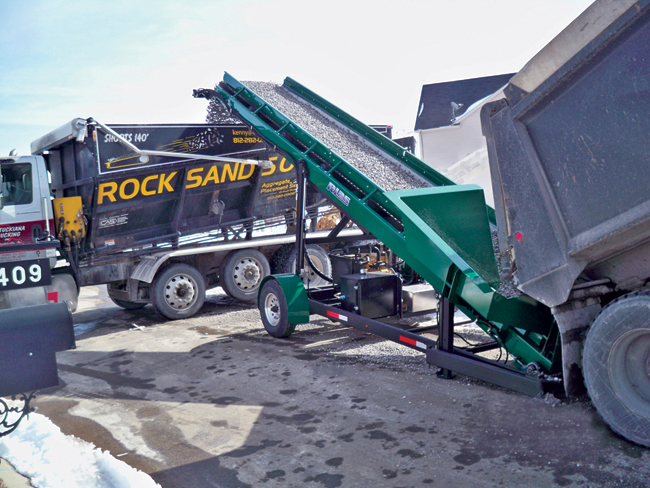Conveyer Belts
It’s a common story for a construction business. You find that your crews are forced to leave the jobsite many times a day to reload trucks, blowers, slingers and everything else that takes product or spoils. This valuable time away from your jobsite is affecting your bottom line, but is there another option? Within the past couple of years, reload conveyors have entered the construction market, saving professionals time and money when it comes to the processes of loading and unloading on site.
Like any other equipment you buy for your business, investing in a reload conveyer requires that you do your homework. Luckily, most reload conveyors available are simple. Picture a portable, construction-grade conveyor belt that’s attached to a steel hopper. Skid steers, wheel loaders and backhoes can dump spoils into the hopper on a busy jobsite and the conveyor carries the product into a truck. Reload conveyers are designed for quick loading of material while eliminating the issues of contamination from dumping material on the ground. Using a reload conveyor alleviates the need for off-site loading, increasing productivity and expediting deadline delivery while ensuring a more environmentally conscience worksite.
In just a matter of minutes, the system can be set up and ready to feed. Most units available are customizable and can be from 16 to 40 ft with either a folding clamshell hopper or a cross-feed hopper system. The units are easily loaded by directly dumping material into the hopper from a dump truck, belt trailer or walking floor. The reload conveyors available today have been used to load mulch, compost, sand, dirt, gravel, rock, seed, manure and asphalt. Other uses for the conveyor are being researched, so talk to the salesperson about the various applicable options for your company.
When considering a reload conveyor, go through this check list: How tall is the unit? What type of engine does it use? What is the length of the feed belt? Does the main conveyor fold? Does the unit have caster wheels? What about remote control operation? What type of material can it reload? And hey, how much is this all going to cost?
Most standard reload conveyors can be delivered within three weeks. However, if you order a custom unit, delivery can take longer. But rest assured: Using a reload conveyor is simple. Most conveyors are around 7,000 lbs and are easily towed to the jobsite using a pintle hitch system behind a pickup, along with the materials that you are using.
Once you have the unit at the jobsite, you can open the hitch system and folding clamshell hopper system. The jack system is hydraulically lowered, which will stabilize the unit. The main conveyor arm is then hydraulically adjusted to the height of what it’s loading and you are ready to start the electronic diesel-powered engine. The rate of the conveyor belt is easily controlled and can be changed as many times as necessary during the loading process. The hopper can be loaded using any bucket loader, a walking floor truck or a dump truck. Other units have caster wheels and non-folding cross feed hopper systems. These units can load while being pulled behind a truck, so reload as you go. With this unit, you can also lock the caster wheels and use as a stationary system.
Maintenance is just as easy. With most reload conveyors, there is a single-side servicing unit, which makes servicing the unit simple. Service intervals are at 500 hours. Most are powered by a 35-hp diesel engine. Hydraulic and engine oil changes are necessary. The hydraulic filter should be changed every 1,000 hours, depending on environmental conditions. The unit is equipped with an indicator, which will alert the need for maintenance. It is necessary to check that the conveyor belt has the proper tension and alignment. In addition, it is necessary to brush, blow and wash the material that might be left behind each day so that it does not get trapped under the conveyor or around the edges. The bottom line of the reload conveyor is that it is an investment in your company.
“While in the process of completing a highway project for the Indiana Department of Transportation, we found that we were wasting over three hours a day by driving our blower truck off the jobsite to reload with material,” says Jay Werlinger, EarthCorp. Inc., an erosion control, seed work and wetland mitigation contractor in Indianapolis. “Using the mobile reload conveyor has enabled us to reload the blower truck at the project site. This has saved us time, which resulted in a $750 savings per hour. Simply put, time is money.”
Jill Werlinger is operations manager at EarthCorp. Industries LLC, based in Lebanon, Ind.






Comments are closed here.